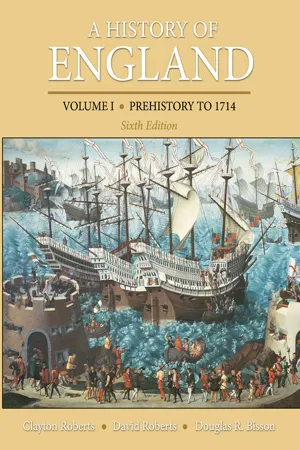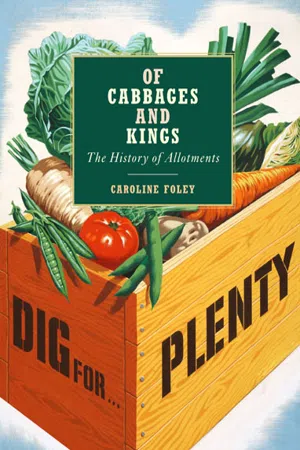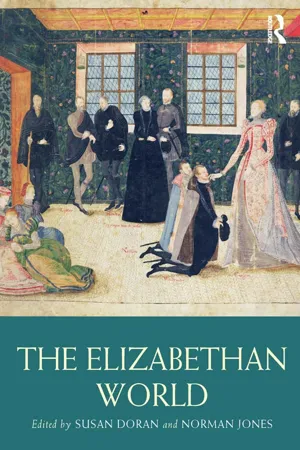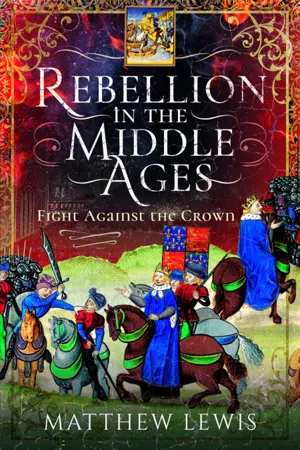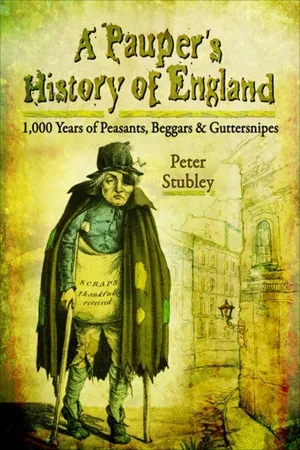History
Kett's Rebellion
Kett's Rebellion was a popular uprising in Norfolk, England in 1549, led by Robert Kett. The rebellion was sparked by grievances over enclosure of common land and high rents. Kett and his followers occupied Norwich and established a camp at Mousehold Heath. The rebellion was eventually suppressed by government forces, and Kett was captured and executed.
Written by Perlego with AI-assistance
Related key terms
Related key terms
1 of 4
Related key terms
1 of 3
5 Key excerpts on "Kett's Rebellion"
- eBook - ePub
A History of England, Volume 1
Prehistory to 1714
- Clayton Roberts, F David Roberts, Douglas Bisson(Authors)
- 2016(Publication Date)
- Routledge(Publisher)
While the villagers of Sampford Courtenay were forcing their priest to say mass in the old style, the copyholders of Norfolk were tearing down the fences on the land of John Flowerdew, a hated lawyer turned country gentleman. John Flowerdew sought to divert the rioters by paying them 40 pence to demolish the fences of his enemy, Robert Ket, a prosperous tanner who owned land worth about £50 a year. When Ket heard of the complaints against his enclosures, he agreed to tear them down. Even more, he vowed to join with the rebels and help them to revenge the harm done by the enclosure of common pasture. He became not only their companion but their captain. Under Ket's leadership the rebels, swollen in numbers to 16,000, marched on Norfolk, captured the city, and established a camp on Mousehold Heath overlooking it. Robert Ket was far removed from the stereotype of a modern revolutionary. He was not young, alienated, unsuccessful, and intellectual; rather, he was 57 years of age, a grandfather, unschooled, a member of an ancient family, a successful tanner, and the owner of two manors. His motives must remain a mystery; one can only guess that he was a decent man, with a keen sense of justice, who was carried forward by the enthusiasm of his compatriots.Apart from Ket, the rebels in Norfolk were composed of the "poor commons," that is, of customary tenants and copyholders, for whom the enemy was the landowning gentry and noble classes. In July 1549 the rebels drew up a list of 29 demands, which they sent as a petition to the King. Their chief demand was that their landlords not be allowed to overstock the commons with their sheep and cattle or to enclose the commons for their own use. The enclosure of arable land was not a grievance, for East Anglia had long been an enclosed country. But the enclosure of the commons for pasture for the lord's sheep was a grievance second only to the lord's overstocking the commons, thus lessening the tenant's right to graze his sheep and cattle there. The rebels also demanded a reduction of rents and entry fines to the levels of 1485. There were numerous complaints against the clergy, and demands that clerical incomes be cut, that tithes be paid in cash, not kind, and that in each parish there be a resident clergyman able to preach. Most radical of all were a series of demands that the people participate in local government, an activity hitherto reserved for the gentry.Ket's rebellion was the most serious challenge made during the century to the Tudor establishment, and its deeper causes lie in both the economic and the intellectual climate of the age. It was, in the first place, a result of a growing population, one that generated both inflation and unemployment. It was the unemployed in Norwich who helped the rebels capture that city. But the chief problem was inflation. The price of foodstuffs rose over 10 percent a year between 1540 and 1550, allowing the tenant to sell on a rising market while paying a fixed rent. The landlord could maintain his real income only by breaking the customary rents and entry fines or by putting more sheep on the commons. During the third and fourth decades of the sixteenth century, entry fines rose by 100 percent. No doubt there were instances of rack-renting—of rents raised two- and threefold—but most landlords barely kept pace with inflation. This fact, however, was of little consolation to the tenant who saw his rents rise in violation of the custom of the manor. As one of them said to his landlord: "My bargain was but to pay for my taking £6 13s 4d yearly.... You can require no more." - eBook - ePub
- Caroline Foley(Author)
- 2014(Publication Date)
- Frances Lincoln(Publisher)
Robert Kett, a wealthy yeoman farmer and a tanner by trade, had been found guilty of illegally enclosing common land at Wymondham, Norfolk, and was fined by the manorial court. This made him an obvious target for a group of local rebels, who in the summer of 1549 came to fill in his ditches and remove his fences. In what appears to have been an extraordinary change of heart, Kett not only agreed to their demands but helped them tear down the fences around his own land and offered to become their leader. He and his brother William marched with the rebels towards Norwich, setting up camps on their gradual progress along the 16 kilometres/10 miles to the city. They gathered more followers as they went, destroying enclosures, taking prisoners and plundering houses for food and provisions.Their numbers were further reinforced six weeks later, when they reached the outskirts of Norwich, by the city’s poor, whose commons had also been partially enclosed. Now a force some 16,000 strong, the rebels settled at Mousehold Heath, on the north-east of Norwich. With their prisoners safely under lock and key, they opened negotiations with the royal councillors concerning illegal enclosures. Protector Somerset (uncle and regent to the young Edward VI) sent ambassadors offering a truce, but this was repelled. An officer of the College of Arms was sent to tell them that even though the camp represented ‘a rebellion’ they would be pardoned as long as they dispersed peacefully. This offer was also rejected.Robert Kett holding a council of war with his rebel army at the ‘oak of reformation’, before they stormed into Norwich in July 1549.Five days later the rebels stormed Norwich and took control of the city. The Marquess of Northampton was ordered to raise an army to quell the revolt. A pitched battle followed in the narrow streets, 300 lives were lost and Northampton’s army was forced to retreat to Cambridge. A second army, led by the Earl of Warwick, was dispatched. Once more the rebels were offered a royal pardon if they would agree to surrender, to no avail. In the clash that followed this refusal, Kett was forced to retreat to an area outside the city. Undaunted, he continued to make raids on Norwich – until the Battle of Dussindale on 27 August, which ended in heavy defeat. The death toll was some 3,000. Only 350 were on Warwick’s side.Kett and his brother were captured the next day and taken to London for trial at the King’s Bench. They were accused of having a rallying cry that incited people to ‘kill the gentlemen’, and of intending to murder king and court. This was an unlikely charge, as they had protected their prisoners and claimed that their argument was with the gentry for breaking the laws on enclosure. Nevertheless, Robert Kett was found guilty of high treason and of levying war upon the king. He was hanged from the walls of Norwich Castle, having been hauled up to the top of the ramparts alive; his body was left to rot until the flesh fell off his bones. His brother William was hanged in chains from the abbey church of his home town, Wymondham. - eBook - ePub
- Susan Doran, Norman Jones, Susan Doran, Norman Jones(Authors)
- 2014(Publication Date)
- Routledge(Publisher)
9 A group in Somerset, forcibly imposing tolls on those who took grain from the market, reportedly declared ‘that they were as good be slain in the market place as starve in their own houses’. In Oxfordshire, carpenter Bartholomew Steer and a few friends tried gathering men for a rebellion in November of 1596. Some in the area had already petitioned the Lord Lieutenant for relief after yet another disastrous harvest; while they adopted the usual forms of petitionary politics, their appeal carried more than the usual implicit threat and noted ‘that if they could not have remedy, they would seek remedy themselves’. The local authorities apparently made one attempt to keep grain in the region, but the Privy Council, worried about more disturbances in London, stymied their effort. Bartholomew Steer, James Bradshaw and a few others discussed the failed petition and planned direct action. They travelled the area to recruit supporters, promising first that ‘there would be a rising of the people to pull down the enclosures … and to lay the same open again’. In the short term, they would feed themselves with ‘corn out of rich men’s barns’. Their talk soon turned from attacking enclosures to attacking the gentlemen themselves, with plans for an armed march to London where they would join with the city’s apprentices. A sentiment that more than food was at issue is perhaps seen in Steer’s resolve that ‘hap what would, for he could die but once and … he would not always live like a slave’. Yet, despite expressions of sympathy, Steer and three others waited in vain atop Enslow Hill on 21 November; none came to join them.Such was the putative ‘Oxfordshire Rebellion’ of 1596. Not much of a rebellion in fact, it nonetheless became one in law. Sir Edward Coke headed up a special committee empowered to torture the men to learn the full details of their plans and pushed for them to be charged with high treason for compassing to levy war against the Queen. Steer and James Bradshaw disappear from the records, presumably having succumbed to either the torture or the imprisonment, but three others were indicted in February before a jury of Oxford gentlemen that included some of their intended victims. Coke’s reading of the treason legislation proved sufficiently troublesome that the justices convened in April to discuss the matter. Three dissented, but the others agreed with Coke. Essentially, an action against a particular enclosure by the people immediately affected would continue to count as riot, but one against enclosures more generally thenceforth constituted high treason. Accordingly, Robert Burton and Richard Bradshaw were tried at Westminster and subsequently hanged, drawn and quartered on Enslow Hill. The decision in this case became an important precedent in the law of treason to be used against future troublemakers and serves as an index of the fears of the authorities in the perilous mid-1590s. - eBook - ePub
Rebellion in the Middle Ages
Fight Against the Crown
- Matthew Lewis(Author)
- 2022(Publication Date)
- Pen and Sword History(Publisher)
Just over a fortnight later, Chief Justice Robert Treselian oversaw the king’s withdrawal of the letters patent he had granted at Mile End. Some may have been collected from the rebels at Smithfield before they were allowed to leave, but in early July, they were all revoked. In the days after Mile End, those who returned to the countryside carrying the king’s letters and displaying his banners carried on their work. Essex saw continued moves against stores of records, including at the archbishop of Canterbury’s manor of Tring. There was trouble in St Albans, Cambridge, Norwich, and Bury St Edmonds. It is striking how much was aimed at rich local abbeys and priories which were considered some of the worst landlords for imposing villeinage and villein tenure. Records were burned, and officials deemed corrupt were killed. Long-running legal battles over the status of tenancies and petty feuds over money were likewise pursued to a settlement.Many rebels were hunted down and prosecuted, sued for their thefts and damage, or executed as traitors. John Ball was tried before the chief justice at St Albans before being executed and his body quartered. There is no real evidence he ever went to London as part of the revolt. He may have remained active in the counties, rallying and organising, but he may just as likely have been made a scapegoat. A convicted heretic with a long history of opposition to the murdered archbishop of Canterbury, his enrolment in the list of chief rebels allowed the uprising to be brushed with the stench of heresy. It warned against listening to critics of the church and made speaking out in favour of the insurrection a whisker away from promulgating Ball’s heresy. The delay between the issue of letters patent and their withdrawal meant that those convicted of crimes, including treason, had acted with the king’s permission. The reversal of a document given by the king using his Great Seal was highly unusual and verged on dishonourable behaviour on the part of the teenager. Richard’s part in the events of June 1381 has often been seen as both personally brave and politically cynical, pacifying and dispersing the mob by pretending to be their champion only to hunt them down once the immediate danger to London was over. There is a hint, though, that he was more genuine and became a victim of those too powerful to accept change, just as his subjects did. - eBook - ePub
A Pauper's History of England
1,000 Years of Peasants, Beggars & Guttersnipes
- Peter Stubley(Author)
- 2015(Publication Date)
- Pen & Sword Military(Publisher)
What is that trembling, that rumbling in the distance like thunder, that quaking of the earth with foot-sized raindrops? The noise grows ever loader – a shrieking unlike anything ever heard, so strange that it can only be compared to the mating cry of a peacock. The guards outside the cell mutter nervously as the walls shake before hurrying away to investigate. The din grows louder and individual voices can be heard. A few moments later and the door leading to the dungeon bangs against the wall as it is flung open. A face appears at the cell door. Keys are produced, the lock is sprung, and we are confronted by a small band of men armed with cudgels, bows and scythes. They have come to release John Ball. Out we go through the main gate, while others scurry past us carrying great piles of parchment – legal records destined for the bonfire. Before us a great chaotic mass of Kentish countrymen. These are not soldiers dressed for battle. They are peasants, craftsmen, small merchants, artisans and lowly priests. Many are barely out of childhood, others are fathers and grandfathers. Their swords and axes are rusty, their bows are blackened with age and smoke, their arrows bent or badly-plumed. But what they lack in equipment, they more than make up for in numbers. And the word is there are more on the way, from the furthest reaches of Kent, from Suffolk and Norfolk, from Essex, from Hertfordshire. There are rumours of 50,000, 100,000, even 200,000.At the head of this advance force stands Wat Tyler, a former soldier himself, veteran of old Edward’s war. He has enough presence to fill a field by himself. Even the nobility admit to his cunning and wit, his skill in public speaking and negotiation. The best insult they can throw at him is that he lacks charm and grace, just because he does not display the fawning courtesy that is expected of a lowborn ‘barelegged ruffian’. But this common citizen of Colchester has taken just a few days to demand the full attention of young King Richard and his advisers. The rebellion appears to have been brewing for a long time, waiting for the right moment to bubble over. That moment arrived on 1 June, when the townsmen of Fobbing in Essex refused to provide the further tax demanded. Thomas Bampton, the lord’s steward, fled in disgrace upon his horse towards London rather than risk his head being impaled upon a spike.The next day, vastly underestimating the breadth of support across the county, the Chief Justice of the Common Bench arrived with twenty soldiers on a commission of trailbaston to punish the rebels. Sir Robert Bealknapp arrived to find not only the townsmen of Fobbing but those of surrounding settlements armed and ready to lay down their lives. The whimpering knight was branded a traitor and forced to swear on the Bible that he would give up his commission. The jurors he had pressed into service for his inquest were tracked down, their houses burned down and their heads removed from their necks. Two days after that the rebels entered Colchester on their way to London. Meanwhile Tyler crossed the river to join a second force from Kent and release John Ball, the man whose preachings have inspired this great rising.
Index pages curate the most relevant extracts from our library of academic textbooks. They’ve been created using an in-house natural language model (NLM), each adding context and meaning to key research topics.
Explore more topic indexes
Explore more topic indexes
1 of 6
Explore more topic indexes
1 of 4
